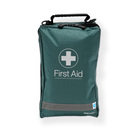Spinal Injuries
Unlock This Video Now for FREE
This video is normally available to paying customers.
You may unlock this video for FREE. Enter your email address for instant access AND to receive ongoing updates and special discounts related to this topic.
Spinal Injury in Road Traffic Collisions
Understanding the Mechanism
Examining the mechanism of spinal injury in road traffic collisions (RTCs) is crucial for effective assessment and treatment.
Impact of Seatbelt Usage
Seatbelts play a critical role in preventing severe injuries during RTCs. However, they may not fully protect the neck and upper spine.
Impact Without Seatbelt
Patients not wearing seatbelts are at risk of severe neck and head injuries due to the unrestrained movement caused by collision impact.
Signs and Symptoms
Recognizing signs of spinal injury involves assessing sensory and motor functions:
- Pins and Needles: Sensations of tingling or numbness in the hands or feet.
- Movement: Testing the ability to move fingers and toes.
- Sensory Perception: Assessing response to touch and painful stimuli.
Management and Precautions
Proper management of suspected spinal injuries includes:
- Stabilization: Immobilizing the patient to prevent further damage.
- Extrication: Handling with caution to avoid exacerbating injuries.
- Monitoring: Regular assessment of sensory and motor functions during extrication.
Consideration of Airbag Deployment
Modern car safety features such as airbags can impact injury severity:
- Airbag Deployment: Indicates the intensity of the collision.
- Injuries from Airbags: Bruising or facial trauma from airbag deployment.
- Safety Precautions: Utilizing protective covers for steering wheels to prevent accidental airbag deployment.
Conclusion
Understanding the mechanisms and potential consequences of spinal injuries in RTCs is essential for providing timely and appropriate medical care, ensuring better outcomes for patients.
- FPOS Extended unit 3 LO6.1 and 6.2



_-Trauma_20x30_CE.jpg)



